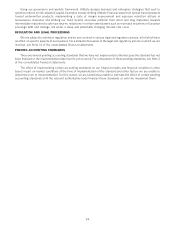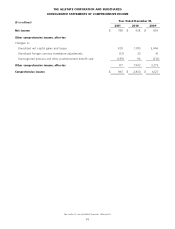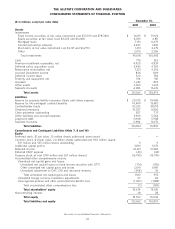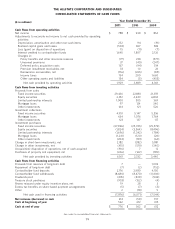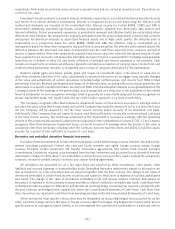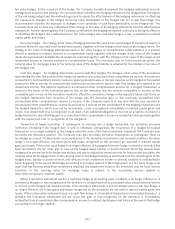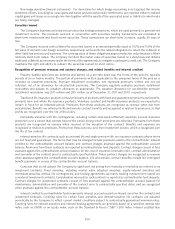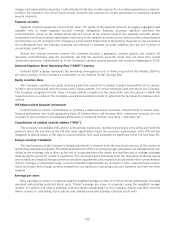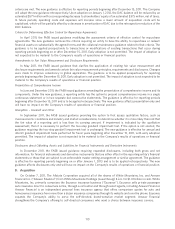Allstate 2012 Annual Report Download - page 190
Download and view the complete annual report
Please find page 190 of the 2012 Allstate annual report below. You can navigate through the pages in the report by either clicking on the pages listed below, or by using the keyword search tool below to find specific information within the annual report.Non-hedge derivative financial instruments For derivatives for which hedge accounting is not applied, the income
statement effects, including fair value gains and losses and accrued periodic settlements, are reported either in realized
capital gains and losses or in a single line item together with the results of the associated asset or liability for which risks
are being managed.
Securities loaned
The Company’s business activities include securities lending transactions, which are used primarily to generate net
investment income. The proceeds received in conjunction with securities lending transactions are reinvested in
short-term investments and fixed income securities. These transactions are short-term in nature, usually 30 days or
less.
The Company receives cash collateral for securities loaned in an amount generally equal to 102% and 105% of the
fair value of domestic and foreign securities, respectively, and records the related obligations to return the collateral in
other liabilities and accrued expenses. The carrying value of these obligations approximates fair value because of their
relatively short-term nature. The Company monitors the market value of securities loaned on a daily basis and obtains
additional collateral as necessary under the terms of the agreements to mitigate counterparty credit risk. The Company
maintains the right and ability to redeem the securities loaned on short notice.
Recognition of premium revenues and contract charges, and related benefits and interest credited
Property-liability premiums are deferred and earned on a pro-rata basis over the terms of the policies, typically
periods of six or twelve months. The portion of premiums written applicable to the unexpired terms of the policies is
recorded as unearned premiums. Premium installment receivables, net, represent premiums written and not yet
collected, net of an allowance for uncollectible premiums. The Company regularly evaluates premium installment
receivables and adjusts its valuation allowance as appropriate. The valuation allowance for uncollectible premium
installment receivables was $70 million and $75 million as of December 31, 2011 and 2010, respectively.
Traditional life insurance products consist principally of products with fixed and guaranteed premiums and benefits,
primarily term and whole life insurance products. Voluntary accident and health insurance products are expected to
remain in force for an extended period. Premiums from these products are recognized as revenue when due from
policyholders. Benefits are reflected in life and annuity contract benefits and recognized in relation to premiums, so that
profits are recognized over the life of the policy.
Immediate annuities with life contingencies, including certain structured settlement annuities, provide insurance
protection over a period that extends beyond the period during which premiums are collected. Premiums from these
products are recognized as revenue when received at the inception of the contract. Benefits and expenses are
recognized in relation to premiums. Profits from these policies come from investment income, which is recognized over
the life of the contract.
Interest-sensitive life contracts, such as universal life and single premium life, are insurance contracts whose terms
are not fixed and guaranteed. The terms that may be changed include premiums paid by the contractholder, interest
credited to the contractholder account balance and contract charges assessed against the contractholder account
balance. Premiums from these contracts are reported as contractholder fund deposits. Contract charges consist of fees
assessed against the contractholder account balance for the cost of insurance (mortality risk), contract administration
and surrender of the contract prior to contractually specified dates. These contract charges are recognized as revenue
when assessed against the contractholder account balance. Life and annuity contract benefits include life-contingent
benefit payments in excess of the contractholder account balance.
Contracts that do not subject the Company to significant risk arising from mortality or morbidity are referred to as
investment contracts. Fixed annuities, including market value adjusted annuities, equity-indexed annuities and
immediate annuities without life contingencies, and funding agreements (primarily backing medium-term notes) are
considered investment contracts. Consideration received for such contracts is reported as contractholder fund deposits.
Contract charges for investment contracts consist of fees assessed against the contractholder account balance for
maintenance, administration and surrender of the contract prior to contractually specified dates, and are recognized
when assessed against the contractholder account balance.
Interest credited to contractholder funds represents interest accrued or paid on interest-sensitive life contracts and
investment contracts. Crediting rates for certain fixed annuities and interest-sensitive life contracts are adjusted
periodically by the Company to reflect current market conditions subject to contractually guaranteed minimum rates.
Crediting rates for indexed annuities and indexed funding agreements are generally based on a specified interest rate
index, such as LIBOR, or an equity index, such as the Standard & Poor’s (‘‘S&P’’) 500 Index. Interest credited also
104


